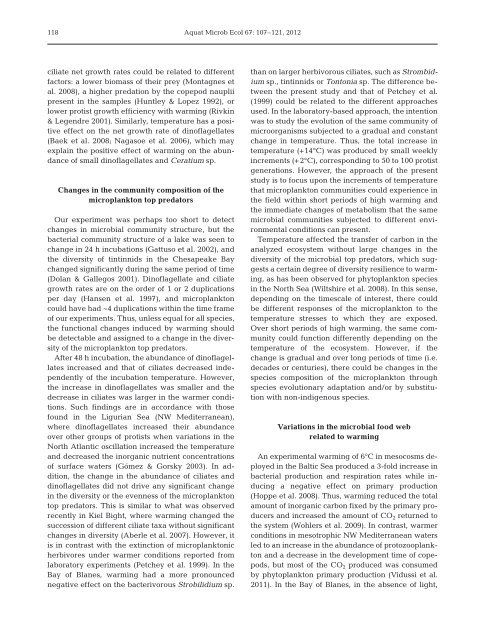Temperature effects on the heterotrophic bacteria, heterotrophic ...
Temperature effects on the heterotrophic bacteria, heterotrophic ...
Temperature effects on the heterotrophic bacteria, heterotrophic ...
You also want an ePaper? Increase the reach of your titles
YUMPU automatically turns print PDFs into web optimized ePapers that Google loves.
118<br />
Aquat Microb Ecol 67: 107–121, 2012<br />
ciliate net growth rates could be related to different<br />
factors: a lower biomass of <strong>the</strong>ir prey (M<strong>on</strong>tagnes et<br />
al. 2008), a higher predati<strong>on</strong> by <strong>the</strong> copepod nauplii<br />
present in <strong>the</strong> samples (Huntley & Lopez 1992), or<br />
lower protist growth efficiency with warming (Rivkin<br />
& Legendre 2001). Similarly, temperature has a positive<br />
effect <strong>on</strong> <strong>the</strong> net growth rate of dinoflagellates<br />
(Baek et al. 2008; Nagasoe et al. 2006), which may<br />
explain <strong>the</strong> positive effect of warming <strong>on</strong> <strong>the</strong> abundance<br />
of small dinoflagellates and Ceratium sp.<br />
Changes in <strong>the</strong> community compositi<strong>on</strong> of <strong>the</strong><br />
microplankt<strong>on</strong> top predators<br />
Our experiment was perhaps too short to detect<br />
changes in microbial community structure, but <strong>the</strong><br />
<strong>bacteria</strong>l community structure of a lake was seen to<br />
change in 24 h incubati<strong>on</strong>s (Gattuso et al. 2002), and<br />
<strong>the</strong> diversity of tintinnids in <strong>the</strong> Chesapeake Bay<br />
changed significantly during <strong>the</strong> same period of time<br />
(Dolan & Gallegos 2001). Dinoflagellate and ciliate<br />
growth rates are <strong>on</strong> <strong>the</strong> order of 1 or 2 duplicati<strong>on</strong>s<br />
per day (Hansen et al. 1997), and microplankt<strong>on</strong><br />
could have had ~4 duplicati<strong>on</strong>s within <strong>the</strong> time frame<br />
of our experiments. Thus, unless equal for all species,<br />
<strong>the</strong> functi<strong>on</strong>al changes induced by warming should<br />
be detectable and assigned to a change in <strong>the</strong> diversity<br />
of <strong>the</strong> microplankt<strong>on</strong> top predators.<br />
After 48 h incubati<strong>on</strong>, <strong>the</strong> abundance of dinoflagellates<br />
increased and that of ciliates decreased independently<br />
of <strong>the</strong> incubati<strong>on</strong> temperature. However,<br />
<strong>the</strong> increase in dinoflagellates was smaller and <strong>the</strong><br />
decrease in ciliates was larger in <strong>the</strong> warmer c<strong>on</strong>diti<strong>on</strong>s.<br />
Such findings are in accordance with those<br />
found in <strong>the</strong> Ligurian Sea (NW Mediterranean),<br />
where dinoflagellates increased <strong>the</strong>ir abundance<br />
over o<strong>the</strong>r groups of protists when variati<strong>on</strong>s in <strong>the</strong><br />
North Atlantic oscillati<strong>on</strong> increased <strong>the</strong> temperature<br />
and decreased <strong>the</strong> inorganic nutrient c<strong>on</strong>centrati<strong>on</strong>s<br />
of surface waters (Gómez & Gorsky 2003). In ad -<br />
diti<strong>on</strong>, <strong>the</strong> change in <strong>the</strong> abundance of ciliates and<br />
dinoflagellates did not drive any significant change<br />
in <strong>the</strong> diversity or <strong>the</strong> evenness of <strong>the</strong> microplankt<strong>on</strong><br />
top predators. This is similar to what was observed<br />
recently in Kiel Bight, where warming changed <strong>the</strong><br />
successi<strong>on</strong> of different ciliate taxa without significant<br />
changes in diversity (Aberle et al. 2007). However, it<br />
is in c<strong>on</strong>trast with <strong>the</strong> extincti<strong>on</strong> of microplankt<strong>on</strong>ic<br />
herbivores under warmer c<strong>on</strong>diti<strong>on</strong>s reported from<br />
laboratory experiments (Petchey et al. 1999). In <strong>the</strong><br />
Bay of Blanes, warming had a more pr<strong>on</strong>ounced<br />
negative effect <strong>on</strong> <strong>the</strong> bacterivorous Strobilidium sp.<br />
than <strong>on</strong> larger herbivorous ciliates, such as Strombidium<br />
sp., tintinnids or T<strong>on</strong>t<strong>on</strong>ia sp. The difference between<br />
<strong>the</strong> present study and that of Petchey et al.<br />
(1999) could be related to <strong>the</strong> different approaches<br />
used. In <strong>the</strong> laboratory-based approach, <strong>the</strong> intenti<strong>on</strong><br />
was to study <strong>the</strong> evoluti<strong>on</strong> of <strong>the</strong> same community of<br />
microorganisms subjected to a gradual and c<strong>on</strong>stant<br />
change in temperature. Thus, <strong>the</strong> total increase in<br />
temperature (+14°C) was produced by small weekly<br />
increments (+2°C), corresp<strong>on</strong>ding to 50 to 100 protist<br />
generati<strong>on</strong>s. However, <strong>the</strong> approach of <strong>the</strong> present<br />
study is to focus up<strong>on</strong> <strong>the</strong> increments of temperature<br />
that microplankt<strong>on</strong> communities could experience in<br />
<strong>the</strong> field within short periods of high warming and<br />
<strong>the</strong> immediate changes of metabolism that <strong>the</strong> same<br />
microbial communities subjected to different envir<strong>on</strong>mental<br />
c<strong>on</strong>diti<strong>on</strong>s can present.<br />
<str<strong>on</strong>g>Temperature</str<strong>on</strong>g> affected <strong>the</strong> transfer of carb<strong>on</strong> in <strong>the</strong><br />
analyzed ecosystem without large changes in <strong>the</strong><br />
diversity of <strong>the</strong> microbial top predators, which suggests<br />
a certain degree of diversity resilience to warming,<br />
as has been observed for phytoplankt<strong>on</strong> species<br />
in <strong>the</strong> North Sea (Wiltshire et al. 2008). In this sense,<br />
depending <strong>on</strong> <strong>the</strong> timescale of interest, <strong>the</strong>re could<br />
be different resp<strong>on</strong>ses of <strong>the</strong> micro plankt<strong>on</strong> to <strong>the</strong><br />
temperature stresses to which <strong>the</strong>y are exposed.<br />
Over short periods of high warming, <strong>the</strong> same community<br />
could functi<strong>on</strong> differently depending <strong>on</strong> <strong>the</strong><br />
temperature of <strong>the</strong> ecosystem. However, if <strong>the</strong><br />
change is gradual and over l<strong>on</strong>g periods of time (i.e.<br />
decades or centuries), <strong>the</strong>re could be changes in <strong>the</strong><br />
species compositi<strong>on</strong> of <strong>the</strong> micro plankt<strong>on</strong> through<br />
species evoluti<strong>on</strong>ary adaptati<strong>on</strong> and/or by substituti<strong>on</strong><br />
with n<strong>on</strong>-indigenous species.<br />
Variati<strong>on</strong>s in <strong>the</strong> microbial food web<br />
related to warming<br />
An experimental warming of 6°C in mesocosms deployed<br />
in <strong>the</strong> Baltic Sea produced a 3-fold increase in<br />
<strong>bacteria</strong>l producti<strong>on</strong> and respirati<strong>on</strong> rates while inducing<br />
a negative effect <strong>on</strong> primary producti<strong>on</strong><br />
(Hoppe et al. 2008). Thus, warming reduced <strong>the</strong> total<br />
amount of inorganic carb<strong>on</strong> fixed by <strong>the</strong> primary producers<br />
and increased <strong>the</strong> amount of CO 2 returned to<br />
<strong>the</strong> system (Wohlers et al. 2009). In c<strong>on</strong>trast, warmer<br />
c<strong>on</strong>diti<strong>on</strong>s in mesotrophic NW Mediterranean waters<br />
led to an increase in <strong>the</strong> abundance of protozooplankt<strong>on</strong><br />
and a decrease in <strong>the</strong> development time of copepods,<br />
but most of <strong>the</strong> CO 2 produced was c<strong>on</strong>sumed<br />
by phytoplankt<strong>on</strong> primary producti<strong>on</strong> (Vidussi et al.<br />
2011). In <strong>the</strong> Bay of Blanes, in <strong>the</strong> absence of light,
















